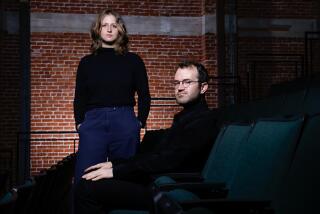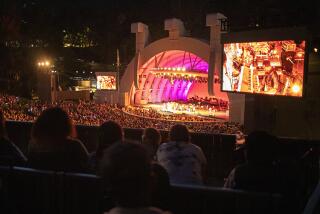A curious night at Largo
“Largo” the movie is a lot like Largo the club. The lighting is low, its attention is 100% on the performers and it doesn’t make things easy for its customers.
“I don’t really know what the audience would be,” says the film’s producer and co-director, Mark Flanagan, mulling the prospects for this unadorned, black-and-white series of performances shot at the tiny Fairfax District music and comedy mecca that he ran for 12 years before moving to a larger location this month.
“People either get Largo or they don’t,” the Belfast native adds. “You’ve got the people that are like, ‘Oh, my God, no texting?’ Yeah, really, no texting.”
No texting, no electronics, no talking -- Flanagan runs a tight ship in service to the artists and an appreciative community of musicians and comedians -- Aimee Mann, Jon Brion, Fiona Apple, Brad Mehldau, Patton Oswalt, Sarah Silverman, et al. -- made the room a uniquely intimate and spontaneous laboratory for experimentation and expression.
But there are no whys or hows in “Largo,” which screens at 4:15 p.m. today at the Landmark and at 9:45 p.m. Wednesday at the Mann Festival Theatre as part of the Los Angeles Film Festival. Flanagan, working with first-time director Andrew Van Baal, chose not to illuminate his enterprise with interviews or behind-the-scenes material.
“The movie that I really love was ‘Jazz on a Summer’s Day,’ you know, the Bert Stern film?” Flanagan says. “It’s from the ‘50s and it’s the Newport Jazz Festival. Mahalia Jackson, Chuck Berry, Louis Armstrong, Chico Hamilton -- it’s a really great collection of artists, and there’s no real explanation, it just goes from one song to the next. I love that.”
Instead of answering questions, the 112-minute film aims to capture the experience of a night at Largo, putting the viewer ringside for an all-star lineup of the club’s standard-bearers.
Flanagan’s vision of simplicity and minimal movement coincided with the supper club’s physical restrictions, as freelance film editor and Largo habitué Van Baal discovered when Flanagan enlisted him to shoot some shows for the club’s website three years ago. That initial footage led to more documentation, and, after accumulating 120 hours, they were ready to turn it into a film.
“It was almost like still photography in a way,” Van Baal says. “You can’t really move around in there, so I felt the best thing to do was just settle down and watch someone in a straightforward way. . . . But to have a whole movie be that way would be very tedious. I think we probably pushed it as far as we could in terms of testing people’s patience in that way.”
He solved the problem by shooting the same singer and same song from different angles on different nights (sometimes asking the artist to wear the same shirt for continuity’s sake), enabling him to edit a seamless sequence with multiple cuts. By the end of the movie, there are even some split-screen images. (Some clips are viewable at the Largo movie website.)
There is some framing, though it would be a stretch to call it a narrative. “Largo” opens with a piano solo by the late Elliott Smith at a sound check and ends with the same piece played by jazz musician Dave Palmer. Employees set up the club at the beginning and stack the chairs at the end.
But the heart of the movie is the performances by a roster of artists who bring a fierce individuality to traditional singer-songwriter basics, including Brion, Apple, Mann, Eels frontman E, Jackson Browne, Davíd Garza, Grant-Lee Phillips, progressive bluegrass band Nickel Creek and Andrew Bird. The Flight of the Conchords form a bridge to the comedy side, represented by Silverman, Paul F. Tompkins and others.
“It starts slow, but then it kind of builds,” Flanagan says. “We wanted somewhat of an arc to it, where it would end with Grant coming full-on with . . . a three-piece band really rocking.”
Whom will they be rocking beyond the film festival audiences?
That’s a question Flanagan will weigh as he forms a plan for his project. He’s counting on advice from his executive producer, director Paul Thomas Anderson, a friend and Largo insider, as he considers distribution possibilities.
“We might retain rights to screen it ourselves or bring it to other festivals or colleges,” says Flanagan, who adds that he is donating the proceeds to the Autism Speaks organization. “Just so that it won’t [become] another obscure DVD thing.”
richard.cromelin @latimes.com
More to Read
The biggest entertainment stories
Get our big stories about Hollywood, film, television, music, arts, culture and more right in your inbox as soon as they publish.
You may occasionally receive promotional content from the Los Angeles Times.






